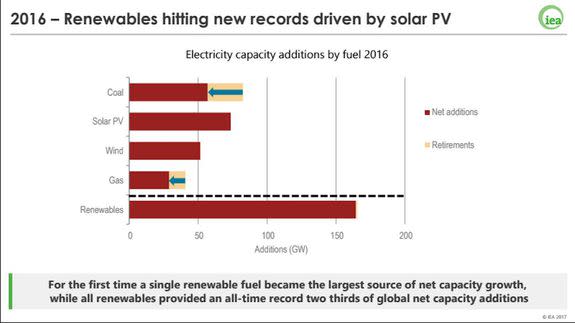Growth in solar power beat all other energy sources in 2016, but Trump still wants more coal

Listening to the Trump administration advocate for reviving coal, one might get the impression that a fossil fuel resurgence is taking place in the U.S. and abroad.
However, the global statistics tell a far different story about where the world is getting its energy, with unprecedented thresholds crossed by renewable energy technologies like solar and wind power.
A major new report released Wednesday morning shows that, for the first time ever, 2016 saw solar photovoltaics, or solar PV, take the lead for the fastest electricity capacity growth when compared to any other fuel, beating the net growth in coal.
The rapid expansion of solar and wind energy in global electricity markets is a positive sign for those working to limit the severity of global warming, which is caused by emissions of greenhouse gases from the burning of fossil fuels, such as coal and oil.
The report, by the International Energy Agency (IEA), finds that renewables represented almost two-thirds of new net electric capacity additions in 2016, with almost 165 gigawatts coming online worldwide. This would be enough energy to power nearly 124 million homes in the U.S.

Image: AP/REX/Shutterstock
The IEA is a Paris-based international organization made up of 29 member states, and it works to enhance energy security and study market trends.
New solar capacity around the world grew by 50 percent in 2016, reaching over 74 gigawatts, with China alone responsible for about half of that expansion. Wind power grew at a slower rate in 2016 than the previous year, which the IEA attributes to the hangover after a 2015 wind energy boom in China.
“We see renewables growing by about 1,000 GW by 2022, which equals about half of the current global capacity in coal power, which took 80 years to build,” said IEA executive director Fatih Birol. “What we are witnessing is the birth of a new era in solar PV. We expect that solar PV capacity growth will be higher than any other renewable technology through 2022.”
The major theme of the report — and one that the Trump administration might want to bury — centers around the fact that China is increasingly leading the world in renewable energy development and deployment, and for some developing countries, such as India, solar and wind energy is already cost competitive with coal.
In other words, the energy choices these populous nations make in the next few years will have huge ramifications for greenhouse gas emissions, the deployment of renewable energy worldwide, and even how far behind the U.S. will be if the government continues to go down a path of trying to revive the fossil fuel industry.
"I think people really underestimate the power of the two most populous countries in the world moving toward a low carbon future, regardless what Europe and America do,” said Tim Buckley, the director of energy finance studies at IEEFA, a think tank that works to accelerate the transition to a sustainable energy economy.
The IEA report contains projections through the year 2022, a period during which it expects global renewable electricity capacity to expand by more than 920 gigawatts, or about 43 percent. China alone would be responsible for 40 percent of this global renewable capacity growth, thanks to the Chinese government's focus on reducing air pollution and other strategic goals.
China currently accounts for half of global solar demand, and Chinese companies make at least half of the solar panels produced annually.
The new report is more bullish on the growth of solar than the 2016 report was, and energy experts have noticed a pattern in which the IEA has had to revise its energy predictions upwards to reflect the real rate of growth in solar, wind, and other renewable energy sources.
"They have consistently underestimated the impact of renewable energy and energy efficiency,” Buckley said of the IEA, while saying its figures remain a gold standard in world energy analysis.

Image: AP/REX/Shutterstock
By the year 2022, total solar capacity around the world is forecast to be 740 gigawatts, which is more than the combined power generation capacities of India and Japan today, the IEA found.
World solar capacity could nearly triple by 2022, to 880 gigawatts, if governments lift economic and technical barriers to deploying more solar installations. Because solar and wind power is more variable than traditional power plants, integrating them into electrical grids poses unique, but not insurmountable, challenges, the report says.
Even with the Trump administration's picking of favorites when it comes to energy sources, the report finds the U.S. will still be the world's second-fastest growing market for renewables through 2022, and that India will overtake the European Union for the number 3 spot.
“America is so far advanced in its transformation that it’s unstoppable,” Buckley said, regarding the Trump administration's energy policies. “It’s a terminal event that coal will continue to lose market share,” he said in an interview. “It will just progressively decline. Trump is slowing the decline, but he can’t stop the decline.”
The report also finds that during the next five years, solar home systems will bring basic electricity services to almost 70 million more people in Asia and sub-Saharan Africa, helping to lift people out of poverty and boosting regional economies.
Renewable power generation grew by 7 percent in 2016, to represent over 24 percent of the global electricity mix, second to coal, the report found. For the first time, a single renewable energy source — solar panels — was the largest source of net electricity growth in a single year, beating coal, wind, and gas.

Image: iea
By 2022, the electricity generation from renewables worldwide is expected to reach 8,000 terawatts hours, which is equal to the total consumption of China, India, and Germany combined, the IEA projects.
While coal will still be the world's largest source of electricity generation in 2022, renewables will be nipping at its heels, having cut its lead in half in just five years. Considering the IEA has a track record of underestimating renewable energy gains, that may be a conservative prediction.
